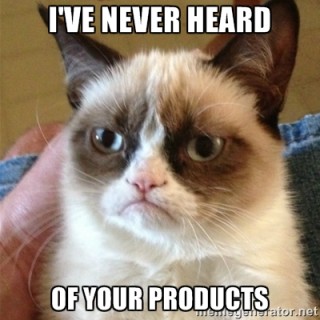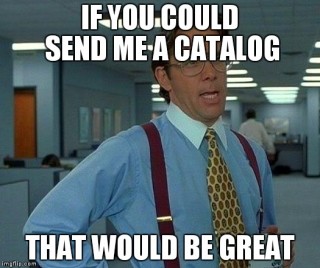
A little over 25 years ago, telemarketers became a nuisance. The Telephone Consumer Protection Act was initially passed in 1991. Some things have improved, and more regulations where adopted. However, there are still those that are a nuisance. These are the ones that are pretty much script-readers, or worse, mindless robocalls. Rather than have computers solve the ideal problem of skillfully targeting high-value customers, some places use it regardless of the negative repercussions. Rather than have knowledgeable sales people, they have minimum wage drones reading scripts in a high-turnover boilerroom, often with poor people skills.
That wasn’t always the case. Telemarketing used to always be effective sales people. They knew their customers and their products. Good ones could sell the proverbial Eskimo an ice machine. They even used to dial the phone by hand, since auto-dialers weren’t around yet. You can see that portrayed by Will Smith in this clip from the movie“The Pursuit Of Happiness”:
Will Smith’s character had a tough job, but notice one thing from the clip – he had lead sheets. They were all calling leads that had been curated and believed to be high-value potential customers. They couldn’t afford, either the cost or negative backlash, to call people indiscriminately. Back then, and still true to today, good sales people have three basic types of customer contacts. They are as follows:
The “Hot” Lead
The “Hot” Lead is the customer that’s ready to buy. You literally just have to shut up and take their money. It’s often the result of a great marketing program, quality products, creative displays at a point-of-sale, or viral recognition of your product through little or no action of your own. The only problem you have is making sure you can satisfy all your Hot leads. Apple occasionally has this problem. Sometimes you can go to an Apple Store and wave a fistful of cash and still have to work to find a sales person not too busy to sell you a product. Other times your product is so popular, that there is a large backlog for getting it into the customer hands. Sometimes, like with Kickstarter, you don’t even have your product yet – and people are still giving you their money.
From a telemarketing perspective, you don’t need an out-bound call center. They are calling you. You just need to insure you have enough staff available to accept the orders as they come in. Or a web site ready to accept the customer order and payment. QVC is an example of this, which capitalizes upon their marketing TV channels. The customers are happy, and the non-customers are happy since they are not bothered. Your Close Ratio is 100%. Live is good.
The “Warm” Lead
The “Warm” Lead is pretty good, too. These people are aware of your product, but may not be interested at the time. However, they have actually given you their contact information to keep that sales channel open. They are actively willing to be a customer. You’ll find you probably have a lot more of these than “Hot” leads, and they are still very valuable to a sales organization. They can be past customers, or current customers which may purchase a different product. They may not be an active customer, but still are interested in the product. They want to be your customer, and just need time and some nudging from a skilled sales person to close the deal. For instance, I get email from Frys.com about electronics sales somewhat frequently. I asked for it, and sometimes that converts to a sale.
From a telemarketing perspective, a small out-bound call center could be used, however these days this is often done through email or social media marketing. The customer or prospective customers are generally happy, and the non-customers are happy since they are not bothered. An outbound telemarketing campaign could possibly hand-dial and be effective, but generally has moved to predictive dialers to improve sales staff efficiency. As long as you don’t get too aggressive, this often works well. Your Close Ratio isprobably over 20%.
The “Cold” Lead

The “Cold” Lead is harder. They may not have even heard of you, or may not even like you. Somehow you have to get that information and interest in quickly before they become disinterested. A skilled sales person make not make a sale, but can at least determine whether to let the contact go or convert that contact into a Warm lead. Part of the skill in not losing the contact, or wasting the sales persons time, is to have the lead qualified in some manner. If you are selling alarm systems to home owners, you don’t start calling people living in apartments. If you are looking married people, perhaps you don’t target rental homes and apartments close to college campuses.
Telemarketing used to work a lot with demographics. Curating information on age, sex, marital status, income, and a wide variety of other factors. This resulted in someone targeted lists of people that were actual potential customers, and capable of using the product and at least converting to Warm Leads. This is still heavily used in advertising, and online with A/B experiments, to get your message out to the target audience and have them come to you as a Warm Lead.
From a telemarketing perspective, it’s tougher today. Privacy issues may make it harder to get good demographics or accurate call lists. The Do Not Call List adds an extra risk. But a reasonable campaign with a predictive dialer can work with little legal risk. With on-line media, it’s easier to generate bad publicity, but with well tailored cold leads and skillful sales people, this also can mitigate risk. The customer may be happy, but the non-customers may be unhappy. At least when the customer answers, there’s a human voice. Your Close Ratio may only 10% depending on the quality of your curated Lead list, but still valuable.
These are the basic types of Leads
This is the basic type of leads sales people of all types deal with all the time. Always with the goal of matching the prospective customer with the desired product. Always wanting to make sure each customer contact is respectful. Predictive dialers can make the sales staff more efficient, but it shouldn’t do so at the expense of the consumer public. With predictive dialers combined with robocalls, a bunch of telemarketers have created a fourth type of Lead which is the most hated of the bunch.
The “Brute Force” Lead
The “Brute Force” Lead has the most controversy, and also violates several telemarketing laws and regulations. It basically hammers the public with unwanted calls. Between predictive dialers and robocalls, the Brute Force telemarketer calls every number they possibly can. A variety of forums complain about these types of calls (and help identify them). They are using robocalls to avoid the costs (and benefits) of the primary three types of Leads. Instead of researching demographics to insure that each potential customer contact has a possibility of converting to a Warm/Hot Lead, the Brute Force just tries to call everyone. Businesses are called, even though the product is targetting residences. People on the Do Not Call List are called, despite prohibitions against it. The leads have 0% qualification, and hopes that the customer will qualify themselves through responding to a Press 1 Campaign.
Instead of having qualified sales agents fielding the calls, cheap or near-zero cost computers are handling the calling and “pre-qualification” of everyone who answers. What actual people they have answering the resulting transfers are often poorly trained, high-turnover script readers. They have to hand off the close to a “Closer” or are just glorified appointment setters. This is the unskilled “sales” force of the telemarketing world.
This results in telemarketing campaigns that drive FTC/FCC complaints and enforcement actions. It results in TCPA lawsuits filed on behalf of individuals. And of course generally leads to a lot of angry people.
From what I’ve seen, most of the companies that do this have questionable products, poor branding, poor social media presence. The worst of them are out-rightscams. The very fact that they are engaging in this type of telemarketing campaign tells me that their product and/or service is too poor to have Hot Leads, not appealing enough to develop Warm Leads, and too lazy to even curate decent Cold Leads.
If your robocall has to ask questions to see if you even qualify for the product, your product probably sucks. And you know it. Your Close Ratio is probably 1% or less, and you have high staff turnover due to dealing with angry calls. And you probably don’t care, as long as that Close Ratio is just high enough to stay profitable.
Why Tormenting Telemarketing?
You see that video clip of Will Smith answering the phone? Getting declined over and over? That’s what I want all the Brute Force telesales people to have to do all day. The Brute Force approach has some effectiveness only because people “disqualify” themselves across thousands of calls. It only has some effectiveness because people don’t get transferred to that dozen or so “sales staff” required to complete the sales process. Tormenting Telemarketinga disruptive technique that they have no defense against – they HAVE to take our calls to make sales, but theyare dependent on us not answeringif we don’t want the product.
Any sales person will tell you that the hardest calls to make are the cold calls. And the worse the lead list, the harder it is. Predictive dialers and robocalls are being used to cheaply generate “Warm” leads to keep the close ratios high enough to be profitable.Forcing the Brute Force call structure into the Cold call structure would devastate them, since they are not prepared. As I’ve noted in other articles, answering the phone increases the Cost of Customer Acquisition, drives down the total volume of calls/customer contacts, reduces Revenue, decreases the Close Ratio. Basically, everything detrimental to their sales process.
So every now and then, answer the phone. Make Brute Force unprofitable.




Comments are closed.